
Automation in Uncertain Times
In a regular business environment, the expectation from IT leaders is to create a resilient IT infrastructure. But in times of upheaval, this becomes even more important. As IT teams need to scale for whatever their end business lines demand from them: it could be a surge in orders, or it could be a deluge of employees working remotely.
Our CIO, Wendy M. Pfeiffer, put this in the right context, “The extent to which your organization has made progress in running things autonomously is a huge factor that contributes to your ability to weather a storm like this [Global Pandemic 2020], even if a significant part of the team is impacted or unable to work”, Ref [1]
Everyone Agrees It Make Sense
Infrastructure and operations teams have struggled with visibility since the dawn of client/server, and today’s disaggregated services make that even worse. The increasing complexity and scale of enterprise cloud almost necessitate automation tools.
Unfortunately, manual processes are still the norm in many IT organizations despite the cost savings and increased speed from automating repetitive operations [2]. Gartner forecasts that by 2024 organizations will lower operational costs by 30% by combining hyper-automation technologies with redesigned operational processes, a transition that might accelerate in response to the current global situation [3].
But Automation, Alone is Not Sufficient
Still, automation alone can not be the panacea for reining in cost and managing infrastructure at scale. Workloads change quickly, and the process of keeping up with application configuration and deployment changes is complex and prone to errors. The result is often service interruptions, wasted resources, and performance bottlenecks — which can defeat the purpose of automation.
Fortunately, AI for IT operations (AIOps) capabilities promise real visibility and stability improvements. AIOps help alleviate this deficit by analyzing data at scale and delivering insights that I&O teams can act on. Similarly, by creating self-service portals for the end business partners, IT teams can now deliver services and applications at lightning speed, but also standardize processes across an organization.

Let us talk about IT Operation Automation
Many Nutanix customers start their IT modernization journeys by adopting hyperconverged infrastructure (HCI). But once you’ve reduced the complexity of managing your infrastructure stack, the next step is to increase levels of integration and automation.
Incidentally, this is true across the board. Gartner predicts that by 2022, 60% of HCI and composable integrated systems will add infrastructure machine learning, analytics, and artificial intelligence for IT operations (AIOps) as software [4].
Those familiar with Nutanix agree that Prism Pro is an essential tool in helping improve the efficiency of IT operations by adding meaningful AI-driven automation.
Creating Codeless Automation
While capacity planning and anomaly detection were always the most recognized benefits of Prism Pro, the recent addition of X-Play (cross-play) for ‘codeless’ automation, has cemented the role of Prism Pro for AI-driven Intelligent Ops. With X-Play, IT admins can set a trigger that can be a system-generated alert or manually trigger the same, defined set of actions to be taken and save-enable the ‘routine’ for true automation running 24x7.
A Real-World Example
Let’s take a concrete example of resource right sizing. With out-of-the-box playbooks for adding memory/CPU on a constrained VM or removing memory/CPU on an over-provisioned VM.
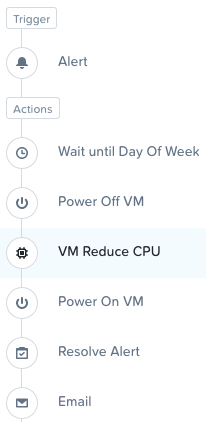
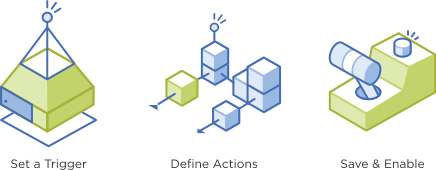
The playbook above shows how, by adding a series of steps, after an alert is received, an over-provisioned VM is turned down, rightsized, and booted up on a weekend, all without needing intervention from the IT admins. But with audit log and email notifications, they can still be in the loop as to what is happening.
A recent survey of IT admins conducted by Nutanix found that IT teams managing small to medium-sized infrastructure, (250-1000VMs), end up spending anywhere from on average 5-10 hrs per week just right-sizing resources (vCPU, vRAM, storage, etc). Imagine how much time IT teams could save by enabling X-Play?
With a library of predefined actions, integration with ServiceNow, and the ability to connect REST API’s and existing scripts, a majority of IT operations can be automated.
Let’s Talk about Applications
IT teams are constantly tasked with delivering infrastructure and applications to their end business units. What if there were a self-service portal that IT could create for provisioning? Likewise, if the end-user could themselves start, stop, and scale an application based on their requirements and team roles, it would empower the end-users and at the same time free up cycles from the IT team.
While many of the fundamental building blocks have long been available, IT Teams miss a unified, full-stack, orchestration layer that works across hybrid multi-cloud environments. Nutanix Calm orchestrates the provisioning, scaling and management of applications across environments, making the entire IT infrastructure more agile and application-centric.
Creating IT as a Service
Self-service of applications dramatically streamlines daily operations and significantly reduces the wait for specialized resources to realize the vision for IT-as-a-Service (ITaaS).
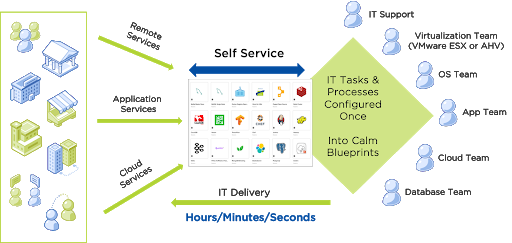
Calm uses blueprints to control all aspects of the application’s lifecycle, such as creating, provisioning, scaling, and cleanup. By adhering to open API standards, blueprints allow developers and administrators to deploy applications across hybrid multi-cloud environments.
In fact, to accelerate automation, in addition to GUI based creation of blueprint, Calm also supports Python-based domain-specific language (DSL) for readable, version-controlled blueprints that can handle even the most complex application scenarios. Once created, a blueprint can be easily published to end-users through the Nutanix Marketplace, instantly transforming a complex provisioning ticket into a simple one-click request.
This creates the perfect DevOps environment, where improvements for software development and test with continuous integration (CI), delivery, and deployment (CD) pipelines, reducing complexity while improving quality and speeding delivery of full-stack application environments expressed as infrastructure and operations as code.
Automation Across Systems
A challenge that many IT teams face with implementing automation is that many times their automation tools remain siloed. Thus operation automation remains disjointed from infra and application automation which may remain disjoined from the ticking tools. At Nutanix, we believe that these silos should not exist.
In fact, Nutanix customers can automate their app lifecycles, integrate system alerts while taking advantage of the approval flow and audit capabilities of popular ITSM tools, including ServiceNow [6], [7]. Adding third-party applications to trigger automation helps customers create an end-to-end IT service management process and makes automation more accessible to IT professionals at all levels.
A Real-World Example
Using the Calm-ServiceNow plugin, IT teams can publish the Calm application as service catalog items in the ServiceNow platform. The next time, a user needs an application, all she needs to do is to file a ticket and the application will be delivered to her.
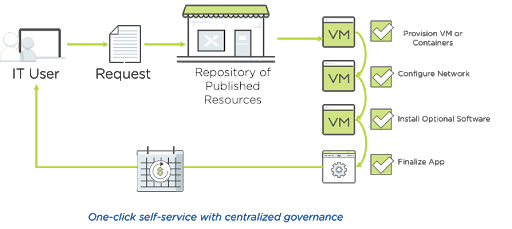
Bringing it All Together
As a leading provider of hyperconverged infrastructure (HCI) and enterprise cloud solutions, Nutanix is uniquely positioned to help companies succeed with automation.
We recognize that intelligent IT operations and advanced automation can transform operations, enable IT as a Service, and better support the needs of developers and business teams.
Both Prism Pro and Calm are natively integrated into our management tool, Prism Central. Our customers don’t have to waste cycles learning a new UI or engage in lengthy service engagements to jump-start automation. Native integration of both products also ensures system knowledge and the learning of run time behavior, key ingredients for automation.
Try it Out
You can try out both automation for operation and application via a guided walk-me test drive.
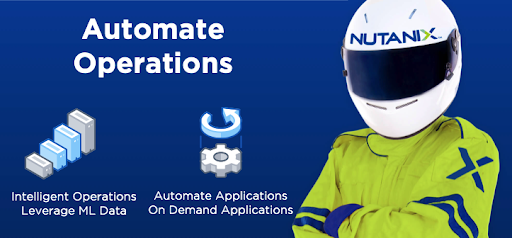
© 2020 Nutanix, Inc. All rights reserved. Nutanix, the Nutanix logo and all Nutanix product and service names mentioned herein are registered trademarks or trademarks of Nutanix, Inc. in the United States and other countries. All other brand names mentioned herein are for identification purposes only and may be the trademarks of their respective holder(s). This post may contain links to external websites that are not part of Nutanix.com. Nutanix does not control these sites and disclaims all responsibility for the content or accuracy of any external site. Our decision to link to an external site should not be considered an endorsement of any content on such a site. Certain information contained in this post may relate to or be based on studies, publications, surveys and other data obtained from third-party sources and our own internal estimates and research. While we believe these third-party studies, publications, surveys and other data are reliable as of the date of this post, they have not independently verified, and we make no representation as to the adequacy, fairness, accuracy, or completeness of any information obtained from third-party sources.
This post may contain express and implied forward-looking statements, which are not historical facts and are instead based on our current expectations, estimates and beliefs. The accuracy of such statements involves risks and uncertainties and depends upon future events, including those that may be beyond our control, and actual results may differ materially and adversely from those anticipated or implied by such statements. Any forward-looking statements included herein speak only as of the date hereof and, except as required by law, we assume no obligation to update or otherwise revise any of such forward-looking statements to reflect subsequent events or circumstances.
References
Ref [1] In Times of Panic, IT Preparation Pays Off
Ref [2] “Take The Mystery Out Of AI For IT Operations (AIOps)” by R Lane, Forrester, 2019
Ref [3] Gartner Top 10 Strategic Technology Trends for 2020
Ref [4] Gartner, “How to Migrate From Legacy Infrastructure to HCI and Integrated Systems”, March, 2019
Ref [6] Nutanix Integration with ServiceNow
Ref [7] Installing and configuring the Nutanix Calm plugin for ServiceNow